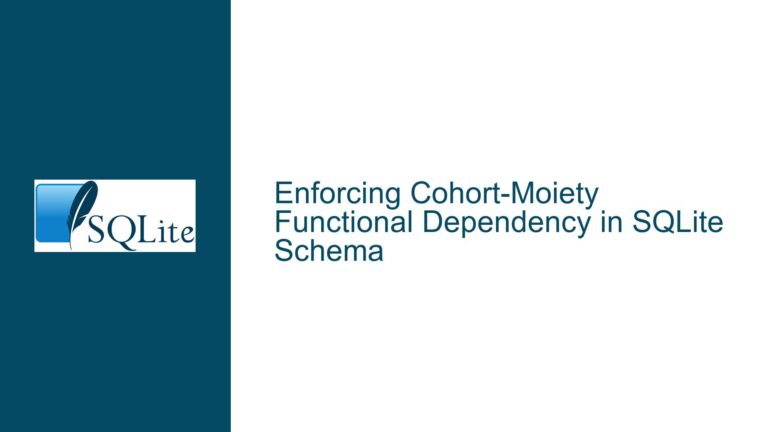Handling Trailing Commas and Empty Column Names in SQLite Virtual Tables
Trailing Commas in Virtual Table Definitions and Empty Column Names
The core issue revolves around the behavior of SQLite when parsing column definitions in CREATE VIRTUAL TABLE statements, particularly when trailing commas are present. A trailing comma in the column list of a virtual table definition does not generate a syntax error. Instead, SQLite interprets the trailing comma as defining an additional column with an empty string ("") as its name. This behavior is observable in virtual table modules such as FTS4, FTS5, and RTREE, where the parser does not enforce strict validation of column names. For example:
CREATE VIRTUAL TABLE test_fts5 USING FTS5(id, name, content='test',);
In this case, the trailing comma after content='test' creates an unnamed column with an empty string identifier. This column is functionally valid but introduces ambiguity in schema design and query operations. The same behavior applies to other virtual table types:
CREATE VIRTUAL TABLE test_rtree USING RTREE(id, name, content,);
Here, the trailing comma after content creates a fourth column with an empty name. The implications of this behavior include:
- Schema Ambiguity: Columns without meaningful names complicate schema documentation and maintenance.
- Query Challenges: Referencing empty-named columns requires escaping or special syntax (e.g.,
SELECT "" FROM table;), which is error-prone. - Data Integrity Risks: Accidental inclusion of empty-named columns might lead to unintended data storage or indexing.
This behavior is not a bug but a deliberate design choice in SQLite’s parsing logic. The SQLite engine treats the comma as a separator between parameters, and an "empty" parameter is interpreted as a column name with an empty string. This approach aligns with SQLite’s broader philosophy of flexibility, allowing developers to define schemas with minimal restrictions—even if such flexibility occasionally leads to unintended outcomes.
SQLite’s Permissive Syntax and Legacy Compatibility Constraints
The permissiveness of SQLite’s syntax in virtual table definitions stems from two interrelated factors: its lightweight parsing strategy and backward compatibility requirements.
1. Parameter-Driven Virtual Table Initialization
Virtual tables in SQLite are instantiated through a CREATE VIRTUAL TABLE statement that passes parameters to the module’s constructor. For example, in USING FTS5(id, name, content='test',), the parameters include column definitions (id, name) and module-specific options (content='test'). The SQLite parser does not validate the semantic correctness of these parameters at the syntax level. Instead, it delegates responsibility to the virtual table module itself to interpret and validate parameters.
For instance, the FTS5 module processes the parameters to configure its full-text search behavior. If a parameter is an unquoted string without an explicit assignment (e.g., content,), it is treated as a column name. If the parameter is an empty string (implied by a trailing comma), it is accepted as a valid column name. This design allows virtual table modules to define their own parameter-handling logic without imposing rigid syntax rules at the parser level.
2. Backward Compatibility and the Cost of Breaking Changes
The FTS4, FTS5, and RTREE modules have historically allowed empty column names due to this permissive parameter handling. Changing this behavior now would break existing applications that rely on the current implementation. For example, a legacy application might include trailing commas in its schema definitions, and enforcing strict validation would render those schemas invalid. SQLite’s commitment to backward compatibility prioritizes stability over strict validation in this context.
3. General Permissiveness in SQLite’s Schema Design
SQLite’s permissiveness extends beyond virtual tables. Standard tables can also be defined with empty names for both tables and columns:
CREATE TABLE ""(a INT, "" INT, c INT);
INSERT INTO "" VALUES(1,2,3);
SELECT "" FROM "" WHERE a=1;
This flexibility underscores SQLite’s philosophy of allowing developers to make decisions—even questionable ones—without imposing arbitrary restrictions. While this approach empowers advanced users, it also places the onus on developers to adopt disciplined schema design practices.
Validating Column Definitions and Mitigating Empty Name Risks
To address the risks associated with empty column names in virtual tables, developers must implement proactive validation at multiple levels: within application code, virtual table modules, and schema design practices.
1. Parameter Validation in Custom Virtual Table Modules
If you are developing a custom virtual table module, enforce strict parameter validation in the xCreate or xConnect methods. For example, iterate through the provided parameters and reject any empty column names by returning an error code (SQLITE_ERROR) and setting an error message:
static int vt_create(sqlite3 *db, void *pAux, int argc, const char *const *argv, sqlite3_vtab **ppVt, char **pzErr) {
for (int i = 0; i < argc; i++) {
if (argv[i][0] == '\0') {
*pzErr = sqlite3_mprintf("Empty column names are not allowed");
return SQLITE_ERROR;
}
}
// Proceed with table creation
}
This ensures that accidental trailing commas or empty parameters are caught during table creation.
2. Schema Review and Static Analysis
Incorporate schema validation into your development workflow:
- Use static analysis tools to scan SQL scripts for trailing commas in
CREATE VIRTUAL TABLEstatements. - Integrate schema validation checks into CI/CD pipelines. For example, a script could parse
CREATEstatements and flag empty column names:
grep -E 'CREATE VIRTUAL TABLE.*, *\);' schema.sql
3. Leveraging SQLite’s Strict Mode (3.37.0+)
While SQLite’s STRICT mode (introduced in version 3.37.0) enforces data type constraints, it does not prevent empty column names. However, you can combine strict mode with check constraints to mitigate risks:
CREATE TABLE my_table (
id INTEGER PRIMARY KEY,
name TEXT NOT NULL,
CHECK(name != '')
) STRICT;
For virtual tables, this approach is not directly applicable, but similar discipline can be enforced in application logic.
4. Query-Time Mitigation
If empty-named columns already exist, use explicit column aliases or ALTER TABLE statements (where supported) to rename them. For virtual tables that do not support ALTER TABLE, create a new table with corrected columns and migrate data:
-- Create a corrected version of the table
CREATE VIRTUAL TABLE test_fts5_corrected USING FTS5(id, name, content='test');
-- Migrate data (assuming no rowid conflicts)
INSERT INTO test_fts5_corrected SELECT id, name, content FROM test_fts5;
-- Drop the original table
DROP TABLE test_fts5;
-- Rename the corrected table
ALTER TABLE test_fts5_corrected RENAME TO test_fts5;
5. Documentation and Team Training
Educate development teams about SQLite’s permissive syntax and the importance of:
- Avoiding trailing commas in schema definitions.
- Using linters or IDE plugins that highlight trailing commas.
- Reviewing schema changes in code reviews.
6. Community Advocacy for Module-Level Strict Modes
Advocate for module-level strict modes in SQLite’s virtual table implementations. For example, propose a parameter like strict=1 for FTS5 to reject empty column names:
CREATE VIRTUAL TABLE test_fts5 USING FTS5(id, name, strict=1);
While this would require changes to SQLite’s core modules, community-driven enhancements could introduce opt-in strict validation without breaking legacy applications.
By understanding SQLite’s design philosophy and implementing layered validation strategies, developers can mitigate the risks of empty column names while retaining the flexibility that makes SQLite a powerful tool for lightweight database applications.






